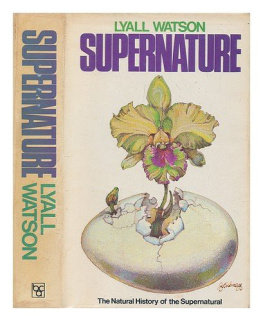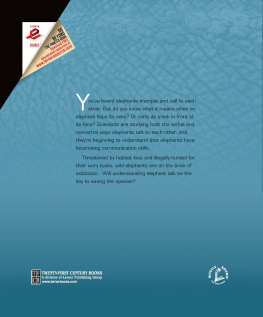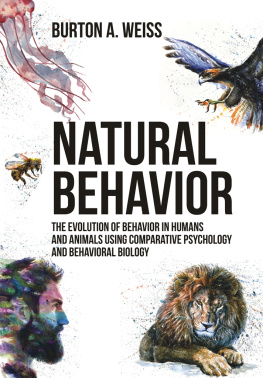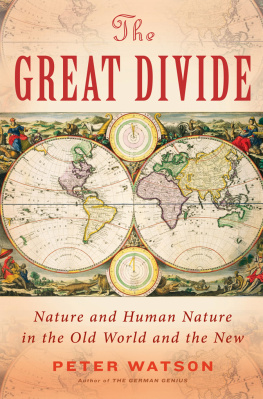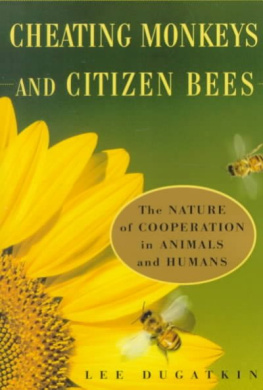

Copyright 2002 by Lyall Watson
All rights reserved
Printed in the United States of America
First published as a Norton paperback 2003
For information about permission to reproduce selections from this book, write to Permissions, W. W. Norton & Company, Inc., 500 Fifth Avenue, New York, NY 10110
Manufacturing by Courier Westford
Book design and drawings by Margaret M. Wagner
Production manager: Julia Druskin
Library of Congress Cataloging-in-Publication Data
Watson, Lyall.
Elephantoms : tracking the elephant / Lyall watson. 1st ed.
p. cm.
ISBN 0-393-05117-X (hardcover)
ISBN 978-0-393-24491-5 (e-book)
1. ElephantsHistory. I. Title.
QL737.P98 W375 2002
599.67dc21 2002000318
ISBN 0-393-32459-1 pbk.
W. W. Norton & Company, Inc., 500 Fifth Avenue, New York, N.Y. 10110
www.wwnorton.com
W. W. Norton & Company Ltd., Castle House, 75/76 Wells Street, London W1T 3QT
The idea of the elephant is imperishable.
ARTHUR SCHOPENHAUER
1833
CONTENTS

LUKIE is seven, an alert and inquisitive child with all the innocent charm of those affected by Downs syndrome.
He doesnt talk much, but communicates well, conveying his needs and concerns through an extensive range of sounds and gestures.
His greatest pleasure is to walk with his father in the swamp forests around their home in central Florida. Lukie recognizes a wide range of animals there, identifying each with a sign of his own devising.
His father has become familiar with the code and confirms every sighting out loud as wood stork, garter snake, or fox squirrel. They get along famously, but recently Lukie has begun to point out creatures his father cant see, and to describe these with a new and unfamiliar gesture.
This doesnt happen every day, but always follows a pause during which Lukie stops to listen to sounds his father cant hear. And sometimes he lifts one arm high over his head in a graceful arc and turns to point into the trees, making a soft sound which turns to a sigh of exasperation when his father clearly fails to understand.
It never helps to pretend to share in Lukies experience. He wont fall for that, but the mystery was finally resolved during a television program which sent Lukie rushing about in high excitement, making the strange sign again and again. The family was watching a National Geographic Special called Elephants: Out of Time, Out of Space!
Armed with this insight, Lukies father began to pay closer attention to the pattern of his sons enthusiastic observations.
There are, of course, no elephants running wild on the banks of the Withlacoochee River in Citrus County, but there were. Lots of them. Several species of proboscid once roamed these coral plains in the company of Paleo-Indian hunter-gatherers. In nearby Silver Springs, a complete mastodon skeleton was recovered recently, riddled with man-made projectile points!
Lukies elephant sightings are sprinkled around his home, but concentrate largely on an ancient sinkhole at the eastern end of placid Lake Consuelothe Waters of Consolation. Sandhill cranes gather here still on the edge of an aquifer which feeds a permanent pond. This persists through the usual dry season, surviving the lowest water levels in living memory, and would probably have been a dependable waterhole even during far drier Pleistocene and postglacial times. Exactly the sort of place where thirsty elephants would have congregated!
Perhaps they still do, bridging a gap of ten thousand years, imbuing that particular glade with a persistent sort of elephantness that is apparent somehow to Lukies special senses. And in this, maybe, he is not alone....

To see the elephant. (U.S. slang):
to get experience of life,
to gain knowledge of the world.
Oxford English Dictionary
AFRICA is the stable heart of old Gondwana, left exposed when other less constant continents drifted away 130 million years ago.
Today it straddles the equator, a vast plateau of ancient rock rising steeply from a narrow coastal strip that remains almost unbroken. There are very few inlets, bays, or gulfs on a coastline shorter than that of Europe.
In the south, a semicircle of misty cliffs plunges vertically eight hundred feet down into deep water that rises silently and suddenly at the rocks, sweeping the unwary away in a relentless undertow.
This is the Cape. The Cape of Storms, washed from the east by the warm flood of the Agulhas Current, bringing coral fish down to the edge of the Roaring Forties; and from the west by an enormous cold currentthe Antarctic Driftcarrying penguins and fur seals up into the tropics.
There is no other country whose coasts face so great a stretch of completely open water. And none which divides two great seas of such different character, blurring the boundary between Atlantic and Indian Oceans, creating a unique climatic zone with its own idiosyncratic weather and its own peculiar flora, both of which have played a vital part in animal and human evolution.

THE Cape Floral Kingdom, one of just six major floral divisions in the world, is known as fynbos (fine bush in Afrikaans) and consists of more than 8,500 species, over 70 percent of which are found nowhere else on earth. It is a rough-edged, hard-leafed evergreen community of heaths, sedges, reedlike restios, delicate gladioli, proteas, aromatic citruses, and pelargoniumsall crowded into a rich palette of saturated colors that can involve as many as 120 different kinds of plants in an area the size of a billiard table.
The composition varies wildly from one slope to another, forging delicate partnerships and stretching out for six hundred miles along the coastal plain between the ocean and a range of mountains guarding the interior. These run roughly parallel to the shore and are older even than the geological disturbance which isolated Africa. They folded inward and upward 250 million years ago during the growing pains of Gondwana, crumpling as the great landmass adjusted to tectonic stress along a fault line that finally separated Africa from South America.
Ancient sedimentary deposits in the area stand now in disarray, some frozen in vertical throws ten thousand feet high, broken only by narrow poorts or gaps that allow inland rivers to escape to the sea. The seaward slopes are fresh, ragged, and beautiful, weathering from gray to gold and rose as the declining sun warms their peaks.
On the coastal plains at their feet, the rivers have cut deep gorges, the mouths of which are mostly drowned by rising sea levels and then partly filled in by beds of marine fossils or chains of lakes. All adding up to an exclusive ecosystem covering perhaps thirty thousand square miles of rolling ground beneath the steep walls of the Langeberg range, which run out eastward until they fall into the sea.
All this happened long before there were elephants.
Proboscidean evolution began here in Africa roughly sixty million years ago, probably with a small creature about the size of a pig, which wallowed in swampy depressions along the Valley of the Nile. It has been called
Next page

